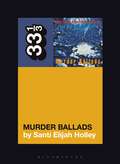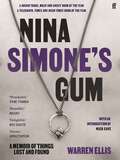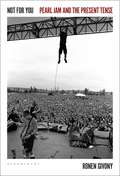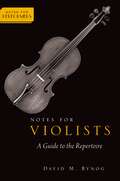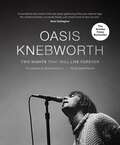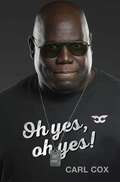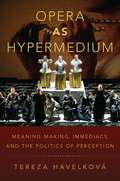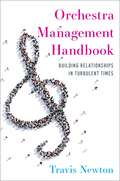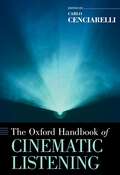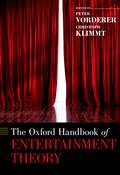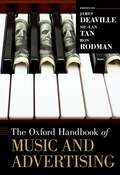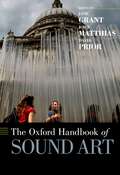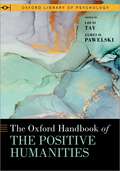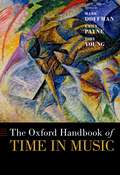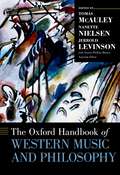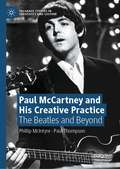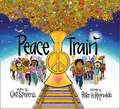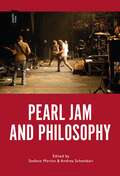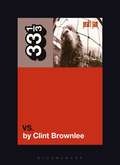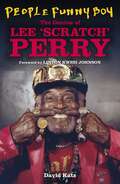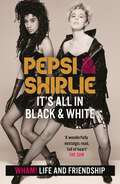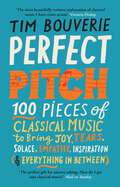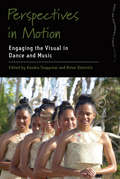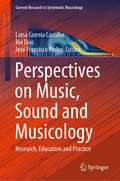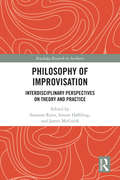- Table View
- List View
Nick Cave and the Bad Seeds' Murder Ballads (33 1/3 #151)
by Santi Elijah HolleyIn a bar called The Bucket of Blood, a man shoots the bartender four times in the head. In the small town of Millhaven, a teenage girl secretly and gleefully murders her neighbors. A serial killer travels from home to home, quoting John Milton in his victims' blood.Murder Ballads, the ninth studio album from Nick Cave and the Bad Seeds, is a gruesome, blood-splattered reimagining of English ballads, American folk and blues music, and classic literature. Most of the stories told on Murder Ballads have been interpreted many times, but never before had they been so graphic or profane. Though earning the band their first Parental Advisory warning label, Murder Ballads, released in 1996, brought Nick Cave and the Bad Seeds their biggest critical and commercial success, thanks in part to the award-winning single, “Where the Wild Roses Grow,” an unlikely duet with Australian pop singer, Kylie Minogue.Closely examining each of the ten songs on the album, Santi Elijah Holley investigates the stories behind the songs, and the numerous ways these ballads have been interpreted through the years. Murder Ballads is a tour through the evolution of folk music, and a journey into the dark secrets of American history.
Nina Simone's Gum: A Memoir of Things Lost and Found
by Warren EllisFrom award-winning musician and composer Warren Ellis comes the unexpected and inspiring story of a piece of chewing gum. Featuring an introduction from Nick Cave.'Warren has turned this memento, snatched from his idol's piano in a moment of rapture, into a genuine religious artefact.'NICK CAVE'In praise of meaning-rich relics and magical things. Totally heartwarming project.'MAX PORTER'A unique study of a fan's devotion, of transcendence and of the artistic vocation - it's got depth and great warmth. It's a beautiful piece of work.'KEVIN BARRYOn Thursday 1 July, 1999, Dr Nina Simone gave a rare performance as part of Nick Cave's Meltdown Festival. After the show, in a state of awe, Warren Ellis crept onto the stage, took Dr Simone's piece of chewed gum from the piano, wrapped it in her stage towel and put it in a Tower Records bag. The gum remained with him for twenty years; a sacred totem, his creative muse, growing in significance with every passing year.In 2019, Cave - his collaborator and great friend - asked Warren if there was anything he could contribute to display in his Stranger Than Kindness exhibition. Warren realised the time had come to release the gum. Together they agreed it should be housed in a glass case like a holy relic. Worrying the gum would be damaged or lost, Warren decided to first have it cast in silver and gold, sparking a chain of events that no one could have predicted, one that would take him back to his childhood and his relationship to found objects.Nina Simone's Gum is about how something so small can form beautiful connections between people. It is a story about the meaning we place on things, on experiences, and how they become imbued with spirituality. It is a celebration of artistic process, friendship, understanding and love.
Not for You: Pearl Jam and the Present Tense
by Ronen GivonyThere has never been a band like Pearl Jam. The Seattle quintet has recorded eleven studio albums; sold some 85 million records; played over a thousand shows, in fifty countries; and had five different albums reach number one. But Pearl Jam's story is about much more than music. Through resilience, integrity, and sheer force of will, they transcended several eras, and shaped the way a whole generation thought about music. Not for You: Pearl Jam and the Present Tense is the first full-length biography of America's preeminent band, from Ten to Gigaton. A study of their role in history – from Operation Desert Storm to the Dixie Chicks; "Jeremy" to Columbine; Kurt Cobain to Chris Cornell; Ticketmaster to Trump – Not for You explores the band's origins and evolution over thirty years of American culture. It starts with their founding, and the eruption of grunge, in 1991; continues through their golden age (Vs., Vitalogy, No Code, and Yield); their middle period (Binaural, Riot Act); and the more divisive recent catalog. Along the way, it considers the band's activism, idealism, and impact, from “W.M.A.” to the Battle of Seattle and Body of War. More than the first critical study, Not for You is a tribute to a famously obsessive fan base, in the spirit of Nick Hornby's Fever Pitch. It's an old-fashioned – if, at times, ambivalent – appreciation; a reflection on pleasure, fandom, and guilt; and an essay on the nature of adolescence, nostalgia, and adulthood. Partly social history, partly autobiography, and entirely outspoken, discursive, and droll, Not for You is the first full-length treatment of Pearl Jam's odyssey and importance in the culture, from the '90s to the present.
Notes for Violists: A Guide to the Repertoire (Notes for Performers)
by David M. BynogNotes for Violists: A Guide to the Repertoire offers historical and analytical information about thirty-five of the best-known pieces for the instrument, making it an essential resource for professional, amateur, and student violists alike. With engaging prose supported by fact-filled analytical charts, the book offers rich biographical information and insightful analyses that help violists gain a more complete understanding of pieces like Béla Bartók's Concerto for Viola and Orchestra, Rebecca Clarke's Sonata for Viola and Piano, Robert Schumann's Märchenbilder for Viola and Piano, op. 113, Carl Stamitz's Concerto for Viola and Orchestra in D Major, Igor Stravinsky's Élégie for Viola or Violin Unaccompanied, and thirty other masterpieces. This comprehensive guide to key pieces from the viola repertoire from the eighteenth through the twentieth century covers concertos, chamber pieces, and works for solo viola by a wide range of composers, including Bach, Telemann, Mozart, Hoffmeister, Walton, and Hindemith. Author David M. Bynog not only offers clear structural analyses of these compositions but also situates them in their historical contexts as he highlights crucial biographical information on composers and explores the circumstances of the development and performance of each work. By connecting performance studies with scholarship, this indispensable handbook for students and professionals allows readers to gain a more complete picture of each work and encourages them to approach other compositions in a similarly analytical manner.
Oasis: THE SUNDAY TIMES BESTSELLER Two Nights That Will Live Forever
by Daniel Rachel Jill Furmanovsky***'A wonderful document of the last great gathering of the pre-internet age. No camera phones, no social media, just a band and its fans as one' -NOEL GALLAGHER On 10th and 11th August 1996, Oasis played the concerts that would define them, a band at the height of their powers playing to over 250,000 people.Twenty-five years on, this is the inside story of those nights, told through the breathtaking photographs of Jill Furmanovsky, granted unprecedented access to Oasis throughout that summer. Also includes newly obtained first-hand accounts from the people who were there - including Noel Gallagher and Alan McGee - in text by award-winning author Daniel Rachel. From relaxed rehearsals and warm-up concerts to Knebworth itself - backstage, onstage, flying high above the site - many of the stunning photographs in this book have never been seen anywhere before.This the definitive account of two nights that a generation will never forget.
Oh yes, oh yes!
by Carl CoxFrom warm up DJ at the birth of Acid House to global main stage headline artist today, Carl Cox continues to inspire and influence audiences and artists. Carl has been everything from a recording artist and producer to label owner, radio DJ and broadcaster. He is still all these things and much more with his star shining brighter than ever. Oh yes, oh yes! tells the story, in his own words, of the man known as 'The Three Deck Wizard' on the rave scene before evolving into 'The People's Choice' and the King of Ibiza; a DJ and artist who remains at the very top of his game and continues to innovate and thrill music-lovers on the world's biggest stages.Starting off as a shelf-stacker, grass cutter and scaffolder in the south London suburbs, Carl's phenomenal talents as a DJ grew out of a love of music nurtured in his parents' front room. In Oh yes, oh yes! he takes us to the heart of the party, from the UK rave scene to Burning Man and from Ibiza to Melbourne, and a career that in in many ways is the story of club culture and an inspiration to all those who choose to follow their dreams turning him into a living legend along the way. Oh yes, oh yes! is a remarkably candid and intimate portrait of an artist who has never lost touch with the people who share the dancefloor with him.'Carl is one of the few true pioneers of UK club culture internationally. He has opened the door to so many DJs and inspired so many, including me.' Gilles Peterson'Carl Cox wrote the script of what it means to be a DJ.' David Guetta'People use the term legend far too easily for my liking but Carl is legend personified.' Grooverider'Carl has always been my favourite. He is the complete DJ, also the DJs DJ. Records come to life when he plays them, rooms come to life when he rocks them. His enthusiasm is infectious, his commitment complete.' Norman Cook aka Fatboy Slim
Opera as Hypermedium: Meaning-Making, Immediacy, and the Politics of Perception
by Tereza HavelkováDrawing on the concept of hypermediacy from media studies, this book situates opera within the larger context of contemporary media practices, and particularly those that play up the multiplicity, awareness and enjoyment of media. It is driven by the underlying question of what politics of representation and perception opera performs within this context. This entails approaching operas as audiovisual events (rather than works or texts) and paying attention to what they do by visual means, along with the operatic music and singing. The book concentrates on events that foreground their use of media and technology, drawing attention to opera's inherently hypermedial aspects. It works with the recognition that such events nevertheless engender powerful effects of immediacy, which are not contingent on illusionism or the seeming transparency of the medium. It analyzes how effects like presence, liveness and immersion are produced, contesting some critical claims attached to them. It also sheds light on how these effects, often perceived as visceral or material in nature, are related to the production of meaning in opera. The discussion pertains to contemporary pieces such as Louis Andriessen and Peter Greenaway's Rosa and Writing to Vermeer, as well as productions of the canonical repertory such as Wagner's Ring Cycle by Robert Lepage at the Met and La Fura dels Baus in Valencia.
Orchestra Management Handbook: Building Relationships in Turbulent Times
by Travis NewtonThose who choose to make the orchestra enterprise their life's work face a host of challenges that have beset orchestra managers since the very beginning of the art form, alongside new challenges that continue to arise in the twenty-first century. Written for those who are contemplating jumping into the orchestra management realm, the Orchestra Management Handbook will provide a significant head-start for people entering this complicated, exciting, and challenging line of work. Whether short-term, long-term, internal, external or existential, an intentional approach to building, maintaining, and sustaining relationships must be at the core of the orchestra manager's daily routine. Few arts organizations have more potential for building community than orchestras. With a typically large permanent complement of artists, a high volume of performances, and a need for large audiences, building community should be central to the internal and external operations of the modern orchestra. Each chapter of this handbook provides practical strategies, tools, and a variety of resources to workers in the orchestra management field, always with an emphasis on building relationships. Throughout the book, author and experienced orchestra manager, violinist, and professor Travis Newton regularly features illustrative case studies highlighting innovative practices being undertaken at orchestras across the country, providing the reader an opportunity to learn from the experiences of others. Additionally, each chapter concludes with a series of discussion questions to ponder, teasing out some of the key concepts.
The Oxford Handbook of Cinematic Listening (Oxford Handbooks)
by Carlo CenciarelliThe Oxford Handbook of Cinematic Listening explores the place of cinema in the history of listening. It looks at the ways in which listening to film is situated in textual, spatial, and social practices, and also studies how cinematic modes of listening have extended into other media and everyday experiences. Chapters are structured around six themes. Part I ("Genealogies and Beginnings") considers film sound in light of pre-existing practices such as opera and shadow theatre, and also explores changes in listening taking place at critical junctures in the early history of cinema. Part II ("Locations and Relocations") focuses on specific venues and presentational practices from roadshow movies to contemporary live-score screenings. Part III ("Representations and Re-Presentations") zooms into the formal properties of specific films, analyzing representations of listening on screen as well as the role of sound as a representational surplus. Part IV ("The Listening Body") focuses on the power of cinematic sound to engage the full body sensorium. Part V ("Listening Again") discusses a range of ways in which film sound is encountered and reinterpreted outside the cinema, whether through ancillary materials such as songs and soundtrack albums, or in experimental conditions and pedagogical contexts. Part VI ("Across Media") compares cinema with the listening protocols of TV series and music video, promenade theatre and personal stereos, video games and Virtual Reality.
The Oxford Handbook of Entertainment Theory (Oxford Handbooks)
by Christoph Klimmt Peter VordererThe proliferation of new digital technologies has given rise to an entirely changed media landscape and revolutionized how we seek entertainment. Older entertainment media like novels, radio, and film have been joined by a host of digital media that smartphones allow us to carry almost anywhere and at all times, from video games and social media to video on demand services. This unprecedented ubiquity of entertainment media calls for new and more sophisticated theories that help us understand the fascination that different entertainment media exert on us and how they change the human experience. The Oxford Handbook of Entertainment Theory surveys and furthers the most influential psychology-driven research on media entertainment to illuminate how people are drawn into media experiences. The 41 chapters in this Handbook not only offer fresh perspectives on established theories but also introduce emerging models and highlight the importance of considering the diverse backgrounds of media users when conducting research. They also cover the motivations and reactions of media users in relationship to different types of media, the trend towards interactive media such as video games and virtual reality, and particularly popular media contents like sexuality, violence, sports, and the news. As the most comprehensive overview of psychology-based research on media entertainment available, this Handbook is an invaluable resource for seasoned researchers and those beginning to learn about the field alike.
The Oxford Handbook of Music and Advertising (Oxford Handbooks)
by Siu-Lan Tan James Deaville Ron RodmanThe Oxford Handbook of Music and Advertising is an essential guide to the crucial role that music plays in relation to the audio or audiovisual advertising message, from the perspectives of its creation, interpretation, and reception. The book's unique three-part organization reflects this life cycle of an advertisement, from industry inception to mass-mediated text to consumer behaviour. Experts well versed in the practice, analysis, and empirical studies of the commercial message have contributed to the collection's forty-two chapters, which collectively represent the most ambitious and comprehensive attempt to date to address the important intersections of music and advertising. Handbook chapters are self-contained yet share borders with other contributions within a given section and across the major sections of the book, so readers can either study one topic of particular interest or read through to gain an understanding of the broader issues at stake. Within the book's Introduction, each editor has provided an overview of the unifying themes for the section for which they were responsible, with brief summaries of individual contributions at the beginnings of the sections. The lists of recommended readings at the end of chapters are intended to assist readers in finding further literature about the topic. An overview of industry practices by a music insider is provided in the Appendix, giving context for the three parts of the book.
The Oxford Handbook of Sound Art (Oxford Handbooks)
by Jane Grant, John Matthias, David PriorSound art has long been resistant to its own definition. Emerging from a liminal space between movements of thought and practice in the twentieth century, sound art has often been described in terms of the things that it is understood to have left behind: a space between music, fine art, and performance. The Oxford Handbook of Sound Art surveys the practices, politics, and emerging frameworks of thought that now define this previously amorphous area of study. Throughout the Handbook, artists and thinkers explore the uses of sound in contemporary arts practice. Imbued with global perspectives, chapters are organized in six overarching themes of Space, Time, Things, Fabric, Senses and Relationality. Each theme represents a key area of development in the visual arts and music during the second half of the twentieth century from which sound art emerged. By offering a set of thematic frameworks through which to understand these themes, this Handbook situates constellations of disparate thought and practice into recognized centers of activity.
The Oxford Handbook of the Positive Humanities (Oxford Library of Psychology)
by Louis Tay, James O. PawelskiThis handbook examines the new and rapidly growing field of the positive humanities--an area of academic research at the intersection of positive psychology and the arts and humanities. Written by leading experts across a wide range of academic disciplines, the volume begins with an overview of the science and culture of human flourishing, covering historical and current trends in this literature. Next, contributors consider the well-being benefits of engagement with the arts and humanities, marking out neurological, cognitive, emotional, behavioral, and social pathways to human flourishing. These pathways lead to detailed investigations of individual fields within the arts and humanities, including music, the visual arts, philosophy, history, literature, religion, theater, and film. Along the way, the book thoroughly synthesizes theory, research, and exemplary practice, concluding with thought-provoking discussions of avenues for public engagement and policy. With its expansive coverage of both the field as a whole and specialized disciplinary and interdisciplinary drivers, The Oxford Handbook of the Positive Humanities advances the literature on the theory and science of well-being and extends the scope of the arts and humanities.
The Oxford Handbook of Time in Music (Oxford Handbooks)
by Mark Doffman, Emily Payne, Toby YoungMusic represents one of humanity's most vivid contemplations on the nature of time itself. The ways that music can modify, intensify, and even dismantle our understanding of time's passing is at the foundation of musical experience, and is common to listeners, composers, and performers alike. The Oxford Handbook of Time in Music provides a range of compelling new scholarship that examines the making of musical time, its effects and structures. Bringing together philosophical, psychological, and socio-cultural understandings of time in music, the chapters highlight the act of 'making' not just as cultural construction but also in terms of the perceptual, cognitive underpinnings that allow us to 'make' sense of time in music. Thus, the Handbook is a unique synthesis of divergent perspectives on the nature of time in music. With its focus on contemporary music (while paying attention to some of the generative temporalities of the nineteenth century), the volume establishes the richness and complexity of so much current music-making and in the process overcomes historic demarcations between art and popular musics.
The Oxford Handbook of Western Music and Philosophy (Oxford Handbooks)
by Ariana Phillips-HuttonWhether regarded as a perplexing object, a morally captivating force, an ineffable entity beyond language, or an inescapably embodied human practice, music has captured philosophically inclined minds since time immemorial. In turn, musicians of all stripes have called on philosophy as a source of inspiration and encouragement, and scholars of music through the ages have turned to philosophy for insight into music and into the worlds that sustain it. In this Handbook, contributors build on this legacy to conceptualize the rich interactions of Western music and philosophy as a series of meeting points between two vital spheres of human activity. They draw together key debates at the intersection of music studies and philosophy, offering a field-defining overview while also forging new paths. Chapters cover a wide range of musics and philosophies, including concert, popular, jazz, and electronic musics, and both analytic and continental philosophy.
Paul McCartney and His Creative Practice: The Beatles and Beyond (Palgrave Studies in Creativity and Culture)
by Phillip McIntyre Paul ThompsonThis book provides fresh insight into the creative practice developed by Paul McCartney over his extended career as a songwriter, record producer and performing musician. It frames its examination of McCartney’s work through the lens of the systems model of creativity developed by Mihaly Csikszentmihalyi and combines this with the research work of Pierre Bourdieu. This systems approach is built around the basic structures of idiosyncratic agents, like McCartney himself, and the choices he has made as a creative individual. It also locates his work within social fields and cultural domains, all crucial aspects of the creative system that McCartney continues to be immersed in. Using this tripartite system, the book includes analysis of McCartney’s creative collaborations with musicians, producers, artists and filmmakers and provides a critical analysis of the Romantic myth which forms a central tenet of popular music. This engaging work will have interdisciplinary appeal to students and scholars of the psychology of creativity, popular music, sociology and cultural studies.
Peace Train
by Cat StevensThe iconic song is now an incredible picture book! Celebrate fifty years of Cat Stevens’ timeless anthem with this joyfully illustrated picture book filled with hope, love, and the celebration of all cultures and identities.
Pearl Jam and Philosophy
by Andrea Schembari Stefano MarinoThe first scholarly discussion on the band, Pearl Jam and Philosophy examines both the songs (music and lyrics) and the activities (live performances, political commitments) of one of the most celebrated and charismatic rock bands of the last 30 years. The book investigates the philosophical aspects of their music at various levels: existential, spiritual, ethical, political, metaphysical and aesthetic. This philosophical interpretation is also dependent on the application of textual and poetic analysis: the interdisciplinary volume puts philosophical aspects of the band's lyrics in close dialogue with 19th- and 20th-century European and American poetry. Through this widespread philosophical examination, the book further looks into the band's immense popularity and commercial success, their deeply loyal fanbase and genuine sense of community surrounding their music, and the pivotal place the band holds within popular music and contemporary culture.
Pearl Jam's Vs. (33 1/3 #154)
by Clint BrownleeVs. is the sound of a band on fire. The same confluence of talent, passion, timing, and fate that made “grunge” the world's soundtrack also lit a short fuse beneath Pearl Jam. The band combusted between late 1992 and mid-1994, the span during which they planned, recorded, and supported their sophomore record. The spotlight, the pressure, the pace-it all nearly turned the thriving act to ash.Eddie Vedder, the reluctant public face of the band, responded by lashing out lyrically. Jeff Ament, Mike McCready, and Stone Gossard, who beheld success with varying degrees of anxious satisfaction, attacked their instruments in solidarity. Dave Abbruzzese welcomed the rock-star lifestyle, and left his mark on the record with more than just potent percussion.Vs. roils with fury-and at times, gently steams-over the trappings of fame, human faults, and societal injustice. The record is a thrashing testament to Pearl Jam's urgent creativity and greater-good interests, and the band's logistical calculations behind it drew a career-defining line in the sand. It promised the world that Pearl Jam would neither burn out nor fade away. This book weaves research, little-known details, and band members' memories into a definitive account of how Vs. set them on a path toward enduring integrity and relevance.
People Funny Boy: The Genius of Lee 'Scratch' Perry
by David Katz'David Katz's in-depth portrayal of his genius is to be commended and is an essential addition to any serious music fan's collection' David Rodigan MBE OD'For the complete picture of this musical genius you can't get better than David Katz's People Funny Boy - if you're into Scratch, it's essential' Don LettsArguably the most influential force in Jamaican music, Lee Perry brought Bob Marley to international stardom and has since collaborated with artists such as Sir Paul McCartney, The Clash and The Beastie Boys. The book delves behind the myth of Perry to give a fuller examination of his life and work through extensive interviews with family members, fellow artists, friends, lovers, enemies, as well as the man himself to present a complex portrait of a unique soul driven by unseen spiritual forces. This revised and expanded edition has been thoroughly updated and completely overhauled to render a more nuanced, accurate and accessible read, with new information on Perry's later years, including his Grammy Award, cessation of herb smoking and final passing, as well as previously unpublished information about his early life, his unique relationship with Marley, and his fabled Black Ark studio.
Pepsi & Shirlie - It's All in Black and White: Wham! Life and Friendship
by Pepsi Demacque-Crockett Shirlie KempLondon. Wham! Pop, glitz and glamour. And two girls with stars in their eyes.Our friendship began one windy day in 1982, outside Finsbury Park tube. It was an instant like at first sight. We were on our way to a Wham! rehearsal. Pepsi was the new girl in the band and over a car stereo, a cassette tape and that journey to Bushey we bonded. We had no idea that we were on the first of many journeys together and that soon we'd be travelling all over Europe, Australia, America, China and Japan. Or that no matter where we went, together, we'd find a way to make every exotic destination feel like home.We'd both been teenagers during the seventies – a dreary and difficult decade, especially if you were young in London and you didn't have much money.So, in 1982, anything was possible for us – a pair of twentysomethings who hadn't been to university, who didn't have any money, who dreamt of singing and dancing, but ultimately lived for fun. Everything felt new and life was a question mark. We had no idea what was lying ahead, but we wanted to say yes.What we didn't know was that we were saying yes to a lifetime of connection that has endured whatever we've done, wherever we've been. From the side of the stage to its centre – we have many stories to tell.And it's all here, it's all in black and white.
Perfect Pitch: 100 pieces of classical music to bring joy, tears, solace, empathy, inspiration (& everything in between)
by Tim Bouverie'Sharply insightful and vividly imaginative... the perfect Christmas gift for anyone asking: 'How do I get into classical music?'' - Rupert Christiansen, Mail on Sunday'A treat from the very first page... written with style and humour, this is a perfect introduction to classical music for a beginner, a companion for the music lover, and sheer entertainment for both.' - Joanna LumleyNearly all of us have the capacity to enjoy classical music but too often we are put off by not knowing where to look, or what we are actually looking for. We feel the need of a guide to help navigate such vast and varied artistic terrain.With this delightful book, historian Tim Bouverie provides just this. Drawing on his lifelong passion for music, he has created a compilation of 100 classical masterpieces sure to move and be enjoyed by almost anyone. Some are well-known, some more idiosyncratic, others hidden gems waiting to be brought into the light. All are intended to comfort and inspire. He provides a short introduction to each piece - variously anecdotal, personal, historical and quirky - and a recommended recording to try.Highly accessible and entertaining, Perfect Pitch is filled with engrossing stories and insights that bring to life 300 years of the world's greatest music.An accompanying playlist is available on Spotify.
Perspectives in Motion: Engaging the Visual in Dance and Music (Dance and Performance Studies #15)
by Kendra Stepputat Brian DiettrichFocusing on visual approaches to performance in global cultural contexts, Perspectives in Motion explores the work of Adrienne L. Kaeppler, a pioneering researcher who has made a number of interdisciplinary contributions over five decades to dance and performance studies. Through a diverse range of case studies from Oceania, Asia, and Europe, and interdisciplinary approaches, this edited collection offers new critical and ethnographic frameworks for understanding and experiencing practices of music and dance across the globe.
Perspectives on Music, Sound and Musicology: Research, Education and Practice (Current Research in Systematic Musicology #10)
by Luísa Correia Castilho Rui Dias José Francisco PinhoThis book gathers a set of works highlighting significant advances in the areas of music and sound. They report on innovative music technologies, acoustics, findings in musicology, new perspectives and techniques for composition, sound design and sound synthesis, and methods for music education and therapy. Further, they cover interesting topics at the intersection between music and computing, design and social sciences. Chapters are based on extended and revised versions of the best papers presented during the 6th and 7th editions of EIMAD–Meeting of Research in Music, Arts and Design, held in 2020 and 2021, respectively, at the School of Applied Arts in Castelo Branco, Portugal. All in all, this book provides music researchers, educators and professionals with authoritative information about new trends and techniques, and a source of inspiration for future research, practical developments, and for establishing collaboration between experts from different fields.
Philosophy of Improvisation: Interdisciplinary Perspectives on Theory and Practice (Routledge Research in Aesthetics)
by Susanne Ravn Simon Høffding James McGuirkThis volume brings together philosophical and interdisciplinary perspectives on improvisation. The contributions connect the theoretical dimensions of improvisation with different viewpoints on its practice in the arts and the classroom. The chapters address the phenomenon of improvisation in two related ways. On the one hand, they attend to the lived practices of improvisation both within and without the arts in order to explain the phenomenon. They also extend the scope of improvisational practices to include the role of improvisation in habit and in planned action, at both individual and collective levels. Drawing on recent work done in the philosophy of mind, they address questions such as whether improvisation is a single unified phenomenon or whether it entails different senses that can be discerned theoretically and practically. Finally, they ask after the special kind of improvisational expertise which characterizes musicians, dancers, and other practitioners, an expertise marked by the artist’s ability to participate competently in complex situations while deliberately relinquishing control. Philosophy of Improvisation will appeal to anyone with a strong interest in improvisation, to researchers working in philosophy, aesthetics, and pedagogy as well as practitioners involved in different kinds of music, dance, and theater performances.
